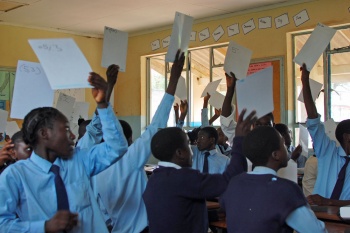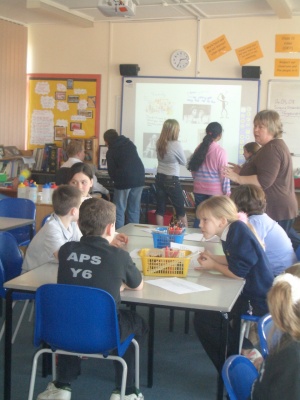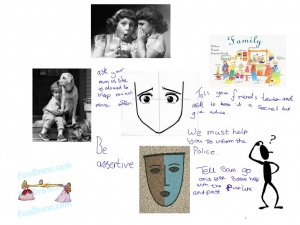Session 2.3 - More on questioning
Learning intentions and objectives.
In this session you will learn about:
- further techniques for questioning and handling responses
- common mistakes made when asking questions in the classroom
- how to increase pupil participation for answering questions
Success criteria.
To meet the learning intentions you will:
- practise effective questioning and handling responses
- role-play a question and answer session with common questioning mistakes to highlight how ineffective some commonly employed questioning strategies can be
- recognise and plan to use a range of effective strategies to increase pupil participation for answering questions
ICT components.
The ICT components you will focus on are
- Using Etherpad to make shared notes
- Planning a lesson with Geogebra
Classroom based activities (with your students, after this session):
- try another lesson with Geogebra.
Resources needed.
Prepare for this activity by printing out from the file the list of Strategies for increasing participation and cut it up so each strategy is on a separate small piece of paper. You can also write them if printing is not possible. Fold each piece separately and keep them in a basket, box, tray or plastic bag.
Making notes with Etherpad
Appoint two scribes, who make notes where appropriate in Etherpad. Occasionally change who the scribes are.
Review of follow-up activities from last session
Last week, what was your practice like?
![]() Writing (5 min): Self assessment of questioning techniques using a checklist. Look at the OER4Schools/Questioning checklist (taken from the green box on page 7 of last week’s VVOB handout on questioning) and see how the statements might have applied to your practice during the past week (i.e. since the last session on questioning). Tick Yes or No.
Writing (5 min): Self assessment of questioning techniques using a checklist. Look at the OER4Schools/Questioning checklist (taken from the green box on page 7 of last week’s VVOB handout on questioning) and see how the statements might have applied to your practice during the past week (i.e. since the last session on questioning). Tick Yes or No.
Reading for further questioning and handling responses
![]() Reading (10 min) for further questioning and handling responses Read pages 2 and 3 of the TESSA handout with the headings ‘Improving the quality of responses’ and ‘Common mistakes in questioning’. Which 2 of these 5 strategies for effective questioning and handling responses would you like to try out in the next week?
Reading (10 min) for further questioning and handling responses Read pages 2 and 3 of the TESSA handout with the headings ‘Improving the quality of responses’ and ‘Common mistakes in questioning’. Which 2 of these 5 strategies for effective questioning and handling responses would you like to try out in the next week?
- Prompting
- Probing
- Refocusing
- Sequencing
- Listening
![]() Role play in pairs (5 min) common questioning mistakes. Have fun role-playing a teacher-student question and answer session where the teacher tries to include as many of the common questioning mistakes as possible. You'll need to be creative to get the most from this activity.
Role play in pairs (5 min) common questioning mistakes. Have fun role-playing a teacher-student question and answer session where the teacher tries to include as many of the common questioning mistakes as possible. You'll need to be creative to get the most from this activity.
Increasing participation in answering questions

Here is a list of strategies for increasing participation in answering questions, also available as a separate file.
- Selecting volunteers – a common method. Ask pupils who know the answer to raise their hands and select one of them to answer.
- Random selection – Write name of every pupil on a piece of paper or an ice lolly stick and put them into a container. Pull out a name (without looking) to select a pupil to answer.
- Teacher nominations - or “no hands up”. Choose specific pupils to answer your question. Select pupils who generally volunteer as well as pupils who avoid volunteering.
- Pupil nominations – Ask the pupil who has just answered to nominate the next speaker (change strategy if same pupils are getting the chance to speak).
- Talking tokens – Cut tokens out of thick paper. Give 2-5 tokens per child depending on the duration of the lesson. Every pupil has to use their tokens by answering questions. (Define use of tokens depending on your lesson, for example, pupils can use tokens by asking questions, volunteering to write on blackboard etc).
- Mini-blackboard display – Every pupil should write their answer on a mini-blackboard and hold up to show the answer. Then select five pupils who have different answers to stand in the front and further question them about their answer.
- Advance selection – Tell pupils who are shy and have fear of giving wrong answers some of the questions that you intend to ask, before the lesson. Ask them to think of an answer and select them for answering.
- Eye contact – Avoid eye contact with dominant speakers. Have a deliberate eye contact with shy pupils indicating that you are expecting them to answer.
- Talk about participation – Plan a lesson that explains usefulness of participation and eliminates fear of wrong answers. Ask pupils to suggest ideas that will help them to participate yet be responsible for discipline.
- Criteria based – If the topic for the day is not serious, set a criterion to select pupils for answering. For example, come forward to answer this question if, ‘you have red shoes, or ‘your name ends with s’, or ‘you are the first child in the family’, or ‘you have one younger sister’, etc
You can print this content on a separate sheet here: OER4Schools/Strategies for increasing participation in answering questions.
![]() Game and discussion (10 min) on strategies for increasing participation in answering questions. Ten volunteers each pick up one folded paper from the basket. They read the strategy on it and then they explain it to other participants through demonstration and/or thinking of practical examples.
Game and discussion (10 min) on strategies for increasing participation in answering questions. Ten volunteers each pick up one folded paper from the basket. They read the strategy on it and then they explain it to other participants through demonstration and/or thinking of practical examples.
![]() Same-task group work (10 min) in pairs on using these strategies. Working in pairs, start a new activity template, and make some notes on which strategies you want to try.
Same-task group work (10 min) in pairs on using these strategies. Working in pairs, start a new activity template, and make some notes on which strategies you want to try.
Video: Questioning Styles and Strategies
In this activity, we will watch two videos. Here are some suggested questions for reflection on both videos:
- What were the different types of questions you identified in the clips? Which types do you think were more effective?
- Which questions or statements seemed effective in extending pupils’ responses and getting them to build on each others’ ideas? Give examples.
- How can you adopt or adapt the strategies for increasing pupil participation in your classroom? What would you like to add or change about the practice in the clips?
![]() Observing, thinking, reflecting (10 min): Watching a video on questioning styles and strategies.
Observing, thinking, reflecting (10 min): Watching a video on questioning styles and strategies.
VIDEO
Questioning Styles and Strategies
Questioning Styles and Strategies
Video/Questioning Styles and Strategies.mp4, https://oer.opendeved.net/wiki/Video/Questioning_Styles_and_Strategies.mp4,This video is available on your memory stick in the video/Video from other organisations folder. Duration: watch on YouTube, local play / download options / download from dropbox)(Series: Video from other organisations, episode N/A)
In this 8-min. sequence, Dr. Harvey Silver guides you through a learning session that may help you develop a wider repertoire of effective questioning practices for your classroom. A larger variety can help you engage learners working at different levels.
![]() Observing, thinking, reflecting (10 min): Watching a video on choosing, annotating and discussing images related to personal safety
Observing, thinking, reflecting (10 min): Watching a video on choosing, annotating and discussing images related to personal safety
VIDEO
Diane Lesson 2 D2.5
Diane Lesson 2 D2.5
Video/Unit 2 session 3---Diane Lesson 2 D2.5.m4v, https://oer.opendeved.net/wiki/Video/Unit_2_session_3---Diane_Lesson_2_D2.5.m4v,This video is available on your memory stick in the video/Video from other organisations folder. Duration: 12:34 watch on YouTube, local play / download options / download from dropbox)(Series: Video from other organisations, episode N/A)
This 10-min. clip illustrates how groups of children aged 10 revisited a collection of images that Diane, a UK primary teacher, had collated during the previous lesson, pertaining to personal safety issues.
![]() Whole class dialogue (10 min) on these videos, and adding useful question types to your activity template. We asked you to reflect on the following:
Whole class dialogue (10 min) on these videos, and adding useful question types to your activity template. We asked you to reflect on the following:
- What were the different types of questions you identified in the clips? Which types do you think were more effective?
- Which questions or statements seemed effective in extending pupils’ responses and getting them to build on each others’ ideas? Give examples.
- How can you adopt or adapt the strategies for increasing pupil participation in your classroom? What would you like to add or change about the practice in the clips?
Share and discuss your observations. Add notes to your activity template as to what you can try in class.
Planning your questioning activity
Write down any further points emerging about questioning and handling responses in the table that you filled in during the first activity in this session.
![]() Same-task group work (10 min): Planning in pairs for a questioning activity. Prepare a 10-minute activity for an impending lesson that focuses specifically on questioning and handling responses related to the lesson topic. Work with a same-grade buddy if available. Use the same activity template that you have already started. Include some of the new ideas that have emerged in this session; be sure to include
Same-task group work (10 min): Planning in pairs for a questioning activity. Prepare a 10-minute activity for an impending lesson that focuses specifically on questioning and handling responses related to the lesson topic. Work with a same-grade buddy if available. Use the same activity template that you have already started. Include some of the new ideas that have emerged in this session; be sure to include
- one of the strategies for improving the quality of responses (TESSA)
- one of the strategies for increasing participation in answering questions
In your pair, discuss which other points about questioning and handling responses should be included in the Questioning checklist? Edit the table using the copy in the checklist file and add your own statements at the bottom.
Notes:
- You may or may not want to trial the same activity: This is up to you. Both of you can plan the same activity, or a different activity.
- Think whether you can include ICT in some way: Can you support the questioning activity with some images? You could use your previously made slideshows. If you run your questioning activity before the Geogebra activity (see below) then you can use the netbooks for both!
![]() Agreeing (5 min) a time for peer observation. At the end of this activity, briefly agree with your partner, when you can observe each other. When you do this observation, make sure you take your (amended) Questioning checklist along.
Agreeing (5 min) a time for peer observation. At the end of this activity, briefly agree with your partner, when you can observe each other. When you do this observation, make sure you take your (amended) Questioning checklist along.
ICT practice: Different-tasks group work with ICT and activity planning
![]() Introduction (5 min) to Traffic lights(a). (Or, "robots", if you prefer.)[Z](Or, "robots", if you prefer.)[R]
Traffic lights (robots)[Z] have three lights - red, orange and green. These lights signal to drivers what action they should take on the road with each coloured light having a different meaning associated with it: Red means STOP; Orange means GET READY TO GO and Green means GO. Their meanings for classroom application are as follows:
Introduction (5 min) to Traffic lights(a). (Or, "robots", if you prefer.)[Z](Or, "robots", if you prefer.)[R]
Traffic lights (robots)[Z] have three lights - red, orange and green. These lights signal to drivers what action they should take on the road with each coloured light having a different meaning associated with it: Red means STOP; Orange means GET READY TO GO and Green means GO. Their meanings for classroom application are as follows:
- RED means “I’m stuck. I need some extra help. I don’t feel I have progressed.”
- ORANGE means “I’m not quite sure. I need a little help. I feel I have made some progress.”
- GREEN means “I understand fully. I’m okay without help. I feel I have progressed a lot.”
While you do practical work in groups, make a stack of your three cards near your groups. Place the colour on top which shows how you are progressing as a group. The facilitator will see the colour and help you appropriately.
![]() Different-tasks group work (15 min) with ICT on various topics. You now have 15 minutes to do ICT practice, and we return to working with spreadsheets. Below are the two sets of exercises with spreadsheets: one you have already encountered in a previous session, and the other is new. Revisit what you have done, and then work on some new things. Remember, that many of the applications you are using are pretty open ended, so explore additional things that interest you.
Different-tasks group work (15 min) with ICT on various topics. You now have 15 minutes to do ICT practice, and we return to working with spreadsheets. Below are the two sets of exercises with spreadsheets: one you have already encountered in a previous session, and the other is new. Revisit what you have done, and then work on some new things. Remember, that many of the applications you are using are pretty open ended, so explore additional things that interest you.
1. Basic Calculations
You can print this content on a separate sheet here: OER4Schools/Spreadsheet exercises/1.
2. Formatting Worksheets
You can print this content on a separate sheet here: OER4Schools/Spreadsheet exercises/2.
Connecting with overarching goals of the programme
![]() Open space (10 min). It's now time for the "open space", that gives you an opportunity to discuss issues that have arisen, and to relate those to the broader context of the programme. Do not just gloss over this section, but make time to raise issues, and probe the progress that you are making. You could use this space to:
Open space (10 min). It's now time for the "open space", that gives you an opportunity to discuss issues that have arisen, and to relate those to the broader context of the programme. Do not just gloss over this section, but make time to raise issues, and probe the progress that you are making. You could use this space to:
- Remind yourselves of the of the Most Significant Change Technique, and e.g. collect more of your stories.
- Discuss your assessment portfolios: Is there anything that you are unsure about? Is it going well? What could be done better?
- Check on the work with the classroom assistants: Is this going well? Are there any tensions? Any observations or tips you can share?
- Reviewing individual ICT practise (such as typing practise).
- If you are preparing a presentation for other teachers, you could work on the presentation (about what you have been learning, stories emerging from MSC).
- Remind those who are doing audio diaries, to upload them.
- You could discuss any other issues that have arisen.
You will find notes and summaries of various techniques and concepts on our reference page, and you might want to refer to those for clarification during this activity if needed.
Follow-up activities
![]() Agreeing follow-up activities (5 min).
Agreeing follow-up activities (5 min).
Part A: Trialling of your activity and peer observation. Try out your new questioning activity in a lesson and ask your buddy to observe you for just that section of the lesson. They should use your modified observation checklist to see if your questioning meets your own goals but can also add their own comments below the table. In turn, observe your buddy using their checklist.
Part B: Trying our different strategies. You might like to try out other strategies in other lessons, for example those you ticked No to or added your own ideas to in the questioning checklist, or other strategies for improving the quality of responses or participation in answering questions.
Part C: Geogebra and netbooks. Do the Geogebra-based activity. As you do the activity in the classroom, try to see how familiar your students are with using the netbooks.
<<< OER4Schools - Home -



